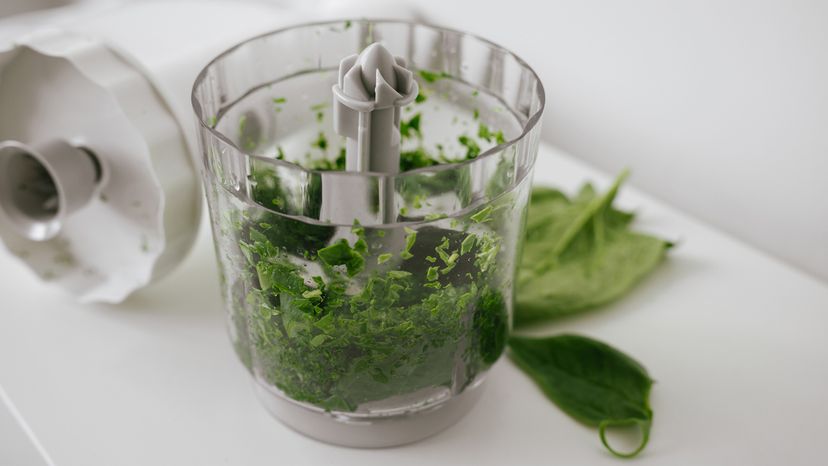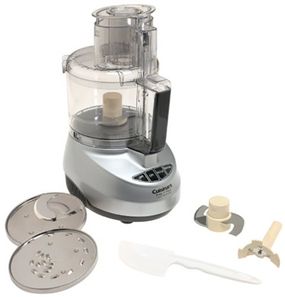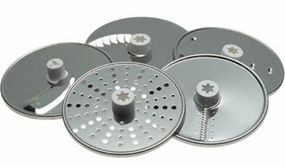
Do you know when to use a food processor vs. blender? They both have blades for chopping food into smaller pieces, so do you really need both kitchen appliances? Learn how food processors and blenders work, and when to use each.
Advertisement

Do you know when to use a food processor vs. blender? They both have blades for chopping food into smaller pieces, so do you really need both kitchen appliances? Learn how food processors and blenders work, and when to use each.
Advertisement
A food processor is a versatile kitchen appliance that can quickly and easily chop, slice, shred, grind and puree almost any food. Some models can also assist the home cook in making citrus and vegetable juice, beating cake batter, kneading bread dough, beating egg whites and grinding meats and vegetables.
The food processor was introduced to the North American market in 1973 by engineer Carl Sontheimer, who had spent a year adapting a French industrial blender for the home cook.
Advertisement
It took a few years for consumers to realize how useful the new appliance could be, but once they did, the food processor became a bestseller.

Modern food processors come in three basic sizes: full, compact and mini. No matter what size they are, however, the basic components are the same: a motor, a bowl with a lid and feed tube, and a set of attachments.

In a basic food processor, the attachments fit over the shaft inside the bowl. Standard attachments for a food processor are an S-shaped blade — also known as a sabatier blade — and shredding and slicing discs.
In addition to the standard attachments that came with your food processor, you can supplement your equipment and make your appliance more versatile by buying additional attachments. Other common attachments include:
Advertisement
Blenders predate food processors by a few years. According to the Illinois State Museum, the first electric blender was developed in 1922 to produce malts and shakes at soda fountains. The first blender patent was issued in 1932.
Blenders rely on liquid ingredients to create a swirling vortex that pulls ingredients down towards the blades for pureeing and then releases them back up to continuously circulate the ingredients and create a smooth mixture.
Advertisement
Every blender is different, but the basic components are:
Advertisement
Food processors and blenders both have blades, but they're not interchangeable. Here are some of the differences.
Blenders work by creating a vortex — a spiral movement of fluid — that pulls ingredients towards the blade. That's why blender blades are angled upward, in contrast to the flat blades of a food processor.
Advertisement
In order to work, blenders require the ingredients to be sufficiently liquid. Once a blender gets started, its high-speed blade pulls ingredients down and forces them back up to create a more uniformly smooth product.
"Machine-powered food processor blades chop very finely, and blender blades, working in a more con- fined space, chop and shear more finely still," writes Harold McGee in "On Food and Cooking: The Science and Lore of the Kitchen."
Blenders excel at creating a uniformly smooth product, like a bisque or smoothie. Food processors are great at chopping food while maintaining some texture.
Most food processors come with multiple blades, while blenders typically have one fixed blade. The interchangeable blades on a food processor are ideal for kitchen tasks like shredding cheese or kneading dough.
Advertisement
In general, food processors are better for cutting, grating, slicing or otherwise processing solid ingredients, while blenders are ideal for crushing and pureeing liquids and solid foods together. Food processors can leak when used for liquids, while blenders can get stuck if there isn't enough liquid.
Here's when to use each.
Advertisement
You can use either tool to puree food, but a blender will yield smoother results — especially for purees with more liquid, like baby food, soups and sauces.
"The pureeing process itself is a physical crushing or shearing that breaks the plant tissue into pieces and liberates thickening molecules from them," writes Harold McGee in "On Food and Cooking: The Science and Lore of the Kitchen." He goes on to say, "Blenders and mortars are the most effective tools for this; food processors slice rather than crush."
When making a hot pureed soup, an immersion blender can be a handy tool; if you don't have one, carefully pour the soup into the blender jar and cover the lid with a towel to prevent splattering.
Blenders were created for making milkshakes, so it makes sense that they would be the best tool for drinks from smoothies to frozen cocktails. A blender's tall jar has room for more liquid than a food processor. The fast, sharp blades of a high-powered blender were made for liquifying frozen fruit.
Use a blender for crushing ice. As appliance tester Cindy Fisher told Tasting Table, "the ice can damage the food processor's chopping blade and plastic container."
The wide bowl of a food processor is better for processing mixtures that are low on liquid, like nut butters.
A food processor is the only appliance that works for cutting butter into flour to make a pie crust.
The shredding disc on your food processor is great for grating ingredients like from carrots to cheese.
A food processor's wide bowl is better for chopping a large batch of vegetables. Use the pulse button to avoid turning your vegetables into a puree.
A blender will yield a smoother pesto, while a food processor will yield a slightly coarser pesto. A Ligurian nonna, however, will tell you to use neither — a mortar and pestle is the traditional way to do it. (The word "pesto" comes from the verb "to pound.")
Advertisement
Please copy/paste the following text to properly cite this HowStuffWorks.com article:
Advertisement